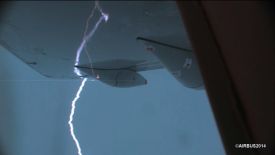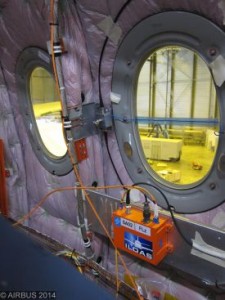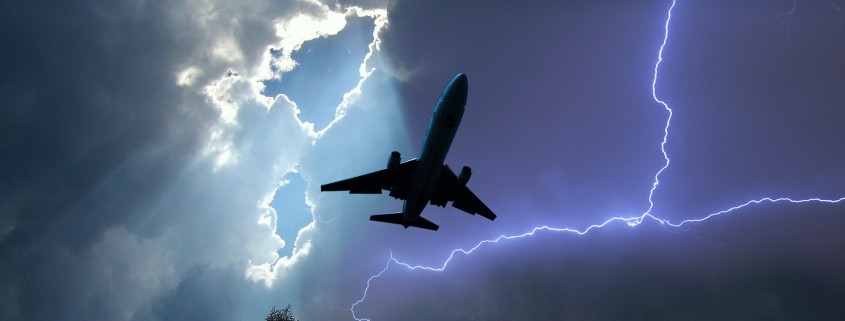
Lightning adherence to the right wing of Airbus A350XWB, during test flights, at April 5th, 2014.
NLR’s measurement system for lightning currents deployed during Airbus icing test flights
What impact does a lightning strike have on an aircraft? To research this, Airbus deployed a measurement system developed by the National Aerospace Laboratory (NLR), Eindhoven University of Technology (TU/e) and Airbus during icing test flights. These test flights were made with the new aircraft from Airbus, the A350 XWB.
ILDAS (In-flight Lightning Damage Assessment System) is a special measurement system that records the lightning currents on airborne commercial aircraft. For this system, NLR developed the advanced measurement electronics that convert electrical signals into digital data. This research was unique in that the sensors — developed by TU/e — were placed on the inside of the cabin. Airbus performed the numerical processing of the data.
The challenge for ILDAS’s designers and developers was to devise a system that would not fail at the critical moment, thus recording accurate measurements during lightning strikes. This was successfully accomplished during the icing test flights. NLR constructed thirteen data acquisition units for A350-prototype no. 1, which were installed throughout the fuselage and measured the electrical and magnetic fields. When the system detected that lightning struck the aircraft, all units immediately conducted highly synchronised measurements, and then quickly saved the data before the next lightning strike.
 The instrumentation systems functioned well during the test flights, which were conducted under severe icing conditions. The Airbus flew through storm clouds and was frequently struck by lightning. There were a total of 62 lightning strikes during the six test flights, including a peak of eighteen strikes in one hour.
The instrumentation systems functioned well during the test flights, which were conducted under severe icing conditions. The Airbus flew through storm clouds and was frequently struck by lightning. There were a total of 62 lightning strikes during the six test flights, including a peak of eighteen strikes in one hour.
These icing test flights provided Airbus with a database, in which it is shown in detail how lightning currents flow through the aircraft. Comparisons were then made to any damage, such as sear marks, on the outside of the aircraft.
As an additional experiment, NLR and TU/e placed two x-ray sensors on board the aircraft. That lightning can also result in x-rays and even bursts of gamma radiation is a relatively new revelation and one that has been met with great academic interest. By combining the x-ray sensors with ILDAS, one can very accurately study the relationship between lightning strikes and x-rays.
For the time being, ILDAS will not be used for commercial flights. However, if the progress continues, ILDAS can be used to reduce flights delays, as the system is capable of transmitting information about lightning strikes to ground control while the aircraft is still airborne.. If an in-flight message is sent from the aircraft in advance, the required personnel and materials can be present on the ground when the aircraft lands.
This project is a continuation of an EU project started in 2009, at which time ILDAS was first developed. See also: https://www.nlr.org/news/lightning-in-the-hangar/
For more info contact Alte de Boer at alte.de.boer@nlr.nl or +31 88 5113605



